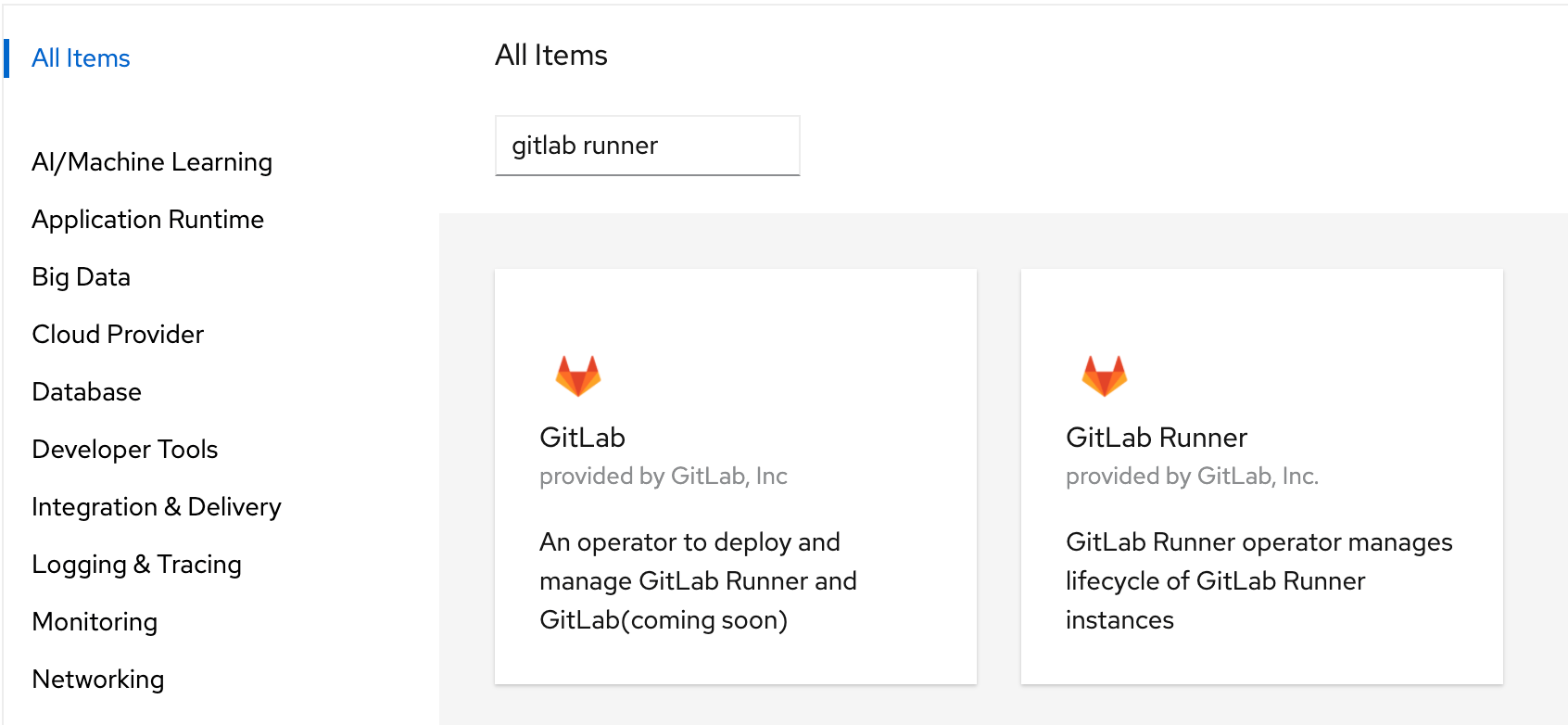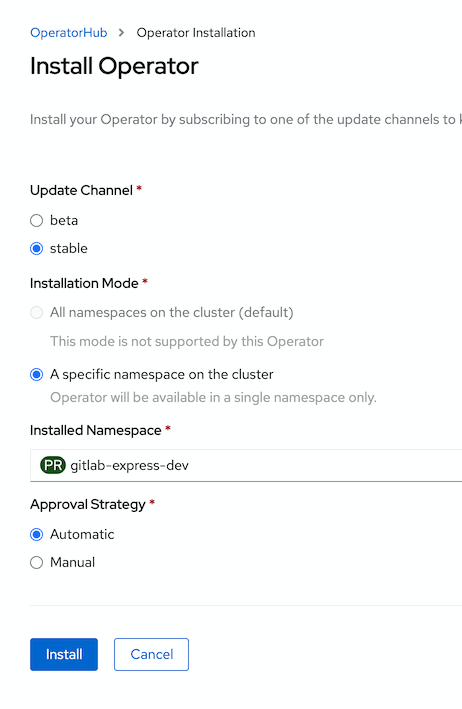Install GitLab Runner Operator
Install on Red Hat OpenShift All tiers All offerings
- Introduced in GitLab 13.3.
- Updated in GitLab 13.7.
You can install the GitLab Runner on Red Hat OpenShift v4 and later using the GitLab Runner Operator available from the stable channel of OperatorHub embedded in OpenShift’s web console. Once installed, you can run your GitLab CI/CD jobs using the newly deployed GitLab Runner instance. Each CI/CD job will run in a separate pod.
Prerequisites
- OpenShift 4.x cluster with administrator privileges
- GitLab Runner registration token
Install the OpenShift Operator
First you must install the OpenShift Operator.
- Open the OpenShift UI and log in as a user with administrator privileges.
- In the left pane, click Operators, then OperatorHub.
-
In the main pane, below All Items, search for the keyword
GitLab Runner. - To install, click the GitLab Runner Operator.
- On the GitLab Runner Operator summary page, click Install.
- On the Install Operator page:
- Under Update Channel, select stable.
- Under Installed Namespace, select the desired namespace and click Install.
On the Installed Operators page, when the GitLab Operator is ready, the status changes to Succeeded.
Install on Kubernetes All tiers All offerings
Introduced in GitLab 14.10.
You can install the GitLab Runner on Kubernetes v1.21 and later using the GitLab Runner Operator available from the stable channel of OperatorHub.io. Once installed, you can run your GitLab CI/CD jobs using the newly deployed GitLab Runner instance. Each CI/CD job will run in a separate pod.
Prerequisites
- Kubernetes v1.21 and later
- Cert manager v1.7.1
Install the Kubernetes Operator
Follow the instructions at OperatorHub.io.
- Install the prerequisites.
- On the top right, select Install and follow the instructions to install OLM and the Operator.
Install GitLab Runner
- Obtain a runner authentication token. You can either:
-
Create the secret file with your GitLab Runner token:
cat > gitlab-runner-secret.yml << EOF apiVersion: v1 kind: Secret metadata: name: gitlab-runner-secret type: Opaque # Only one of the following fields can be set. The Operator fails to register the runner if both are provided. # NOTE: runner-registration-token is deprecated and will be removed in GitLab 18.0. You should use runner-token instead. stringData: runner-token: REPLACE_ME # your project runner token # runner-registration-token: "" # your project runner secret EOF -
Create the
secretin your cluster by running:kubectl apply -f gitlab-runner-secret.yml -
Create the Custom Resource Definition (CRD) file and include the following configuration.
cat > gitlab-runner.yml << EOF apiVersion: apps.gitlab.com/v1beta2 kind: Runner metadata: name: gitlab-runner spec: gitlabUrl: https://gitlab.example.com buildImage: alpine token: gitlab-runner-secret EOF -
Now apply the
CRDfile by running the command:kubectl apply -f gitlab-runner.yml -
Confirm that GitLab Runner is installed by running:
kubectl get runner NAME AGE gitlab-runner 5m -
The runner pod should also be visible:
kubectl get pods NAME READY STATUS RESTARTS AGE gitlab-runner-bf9894bdb-wplxn 1/1 Running 0 5m
Install other versions of GitLab Runner Operator for OpenShift
If you do not want to use the version of GitLab Runner Operator that’s available in the Red Hat OperatorHub, you can install a different version.
To find out the official currently-available Operator versions, view the tags in the gitlab-runner-operator repository.
To find out which version of GitLab Runner the Operator is running, view the contents of the
APP_VERSION file of the commit or tag you are interested in, for example, https://gitlab.com/gitlab-org/gl-openshift/gitlab-runner-operator/-/blob/1-17-stable/APP_VERSION.
To install a specific version, create this catalogsource.yaml file and replace <VERSION> with a tag or a specific commit:
v0.0.1-<COMMIT>. For example: registry.gitlab.com/gitlab-org/gl-openshift/gitlab-runner-operator/gitlab-runner-operator-catalog-source:v0.0.1-f5a798af.apiVersion: operators.coreos.com/v1alpha1
kind: CatalogSource
metadata:
name: gitlab-runner-catalog
namespace: openshift-marketplace
spec:
sourceType: grpc
image: registry.gitlab.com/gitlab-org/gl-openshift/gitlab-runner-operator/gitlab-runner-operator-catalog-source:<VERSION>
displayName: GitLab Runner Operators
publisher: GitLab Community
Create the CatalogSource with:
oc apply -f catalogsource.yaml
In a minute the new Runner should show up in the OpenShift cluster’s OperatorHub section.
Uninstall Operator
Uninstall on Red Hat OpenShift
-
Delete Runner
CRD:kubectl delete -f gitlab-runner.yml -
Delete
secret:kubectl delete -f gitlab-runner-secret.yml -
Follow the instructions at the Red Hat documentation for Deleting Operators from a cluster using the web console.
Uninstall on Kubernetes
-
Delete Runner
CRD:kubectl delete -f gitlab-runner.yml -
Delete
secret:kubectl delete -f gitlab-runner-secret.yml -
Delete the Operator subscription:
kubectl delete subscription my-gitlab-runner-operator -n operators -
Find out the version of the installed
CSV:kubectl get clusterserviceversion -n operators NAME DISPLAY VERSION REPLACES PHASE gitlab-runner-operator.v1.7.0 GitLab Runner 1.7.0 Succeeded -
Delete the
CSV:kubectl delete clusterserviceversion gitlab-runner-operator.v1.7.0 -n operators
Configuration
To configure GitLab Runner in OpenShift, see the Configuring GitLab Runner on OpenShift page.


